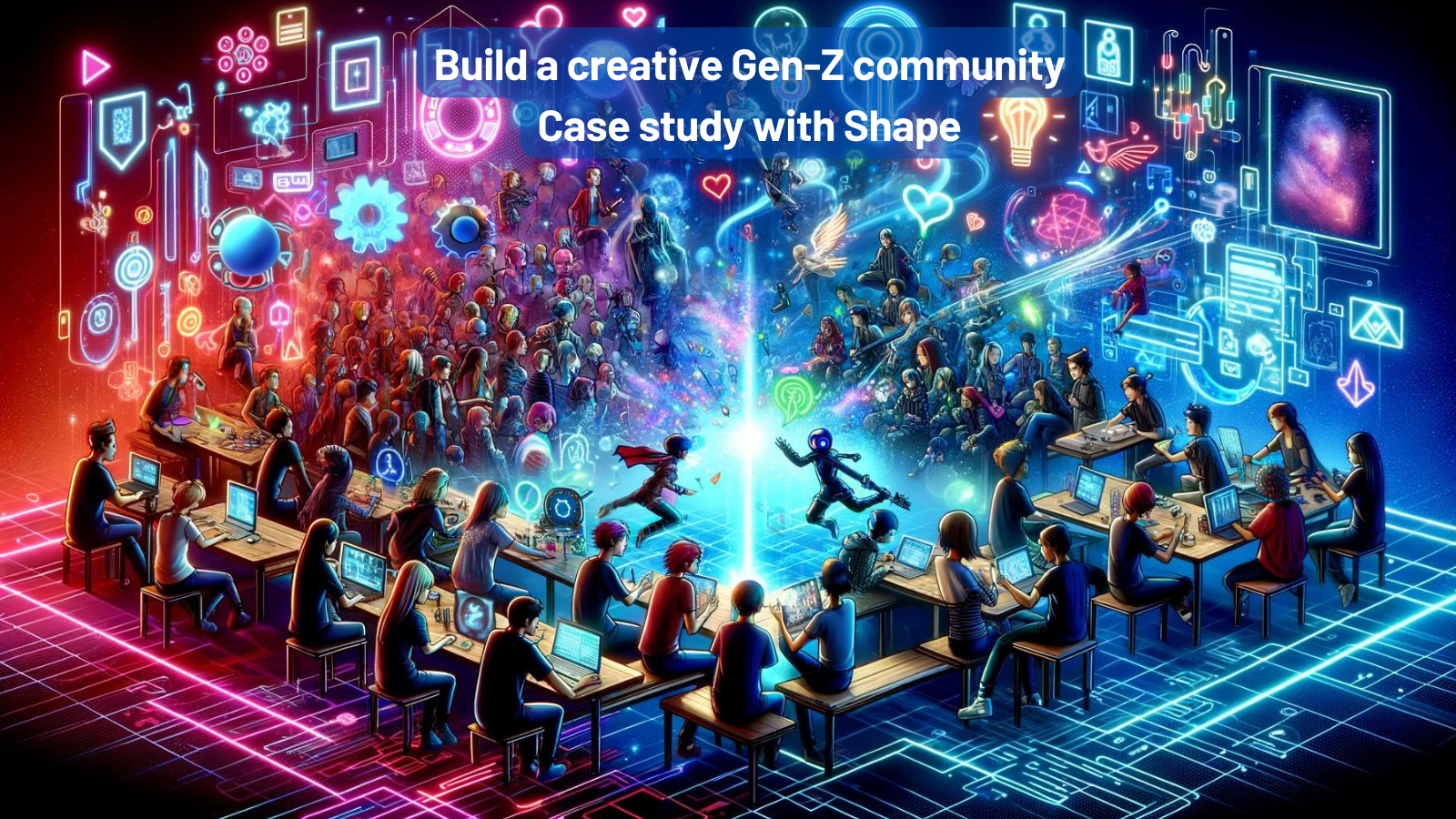How to build a creative Gen-Z community? Case study with Shape - Part 1

TLDR: Shapes’ engagement with characters from popular anime and games highlights the creativity of its Gen-Z user base. Discussions range from fantasy battles to character development, showing a deep dive into role-play and narrative creation.
In today's digital landscape, engaging with Gen-Z requires innovative approaches. Shape, an AI chatbot lab, is at the forefront of this, harnessing AI to tap into the creative potential of Gen-Z. By blending technology with the unique perspectives of this generation, we can foster vibrant, dynamic communities. Shape's AI tools offer a way to understand and leverage Gen-Z's creativity, making community building not just a task, but an exciting journey of collaboration and innovation.
Shape stands out because its user base is predominantly Gen-Z, spanning middle school, high school, and college students. This focus has organically grown its communities to over 20,000 members without any initial marketing efforts. This remarkable growth underscores the platform's appeal and the resonating power of AI-driven engagement with the younger generation. Shape's ability to connect and grow with Gen-Z showcases the potential of AI in fostering strong, vibrant communities.
Lesson 1: Gen-Z loves characters.
The allure of Shape's communities lies in their deep connection with anime and video games, particularly popular among Gen-Z. Characters like Akira, Misato Katsuragi from "Neon Genesis Evangelion," Nagito Komaeda from "Danganronpa," Satoru Gojo from "Jujutsu Kaisen," and Orihime from "Bleach" dominate discussions. Furthermore, games like "Genshin Impact" and "Minecraft" resonate strongly. This shared passion for anime and gaming not only fuels engagement but also cultivates a shared identity, making Shape's communities a hub for like-minded individuals.
For communities not drawn to existing characters, the allure of fantasy and magical beings like angels and mythical creatures offers a captivating alternative. This fascination with the fantastical enriches role-play experiences, making them highly popular. Such elements not only add depth to community interactions but also encourage creativity and imagination, allowing members to craft and inhabit rich, otherworldly narratives. This unique blend of fantasy and engagement creates a vibrant tapestry of stories and characters, fostering a deeply immersive and inclusive community atmosphere.
At CommunityOne, we've observed a similar trend with our product, questGPT, which allows members to engage in DnD games guided by an AI-powered game master. This platform has attracted a significant following, with many users showing a keen interest in superpowers and battle scenes. questGPT's ability to captivate users by immersing them in adventurous narratives and interactive gameplay highlights the growing appeal of immersive, story-driven experiences in community engagement. This reflects a broader shift towards dynamic and interactive community-building strategies that resonate deeply with users' interests and passions.
Lesson 2: Gen-Z loves chatting
In the Shape’s Gen-Z communities, conversations with characters often revolve around vibrant and imaginative themes. Fantasy battles are a hot topic, with members discussing the creation of servers dedicated to role-played combat and adventures. Character development is deeply explored, with in-depth conversations about backstories and traits, indicating a strong focus on narrative depth and personal growth. Magical and supernatural elements are frequently mentioned, hinting at plots filled with magic, supernatural occurrences, and otherworldly adventures. Anime-inspired scenarios are also popular, with members recreating or inventing stories in the style of their favorite anime, blending the lines between fiction and community interaction. These discussions underscore the community's creative engagement and the rich, diverse tapestry of its shared interests.
Some actual examples:
Members actively engage in discussions around a character named Akira, incorporating this character into various role-play scenarios and interactions. These discussions often depict Akira in diverse situations, from exhibiting shyness to participating in playful banter or dramatic exchanges with others. Conversations also delve into Akira's emotional states, such as stress or causing others to blush, highlighting Akira as a central figure in ongoing role-play narratives. This level of engagement with Akira's character underscores the depth of community involvement and the creative storytelling.
Satoru Gojo from "Jujutsu Kaisen," has become a focal point in role-playing contexts. Members vividly discuss Gojo's involvement in battles, his unique Limitless Cursed Technique, and dramatic scenarios like domain expansion and confrontations with other characters. These conversations reflect the members' deep engagement with Gojo's character, showcasing their enthusiasm for weaving complex, imaginative role-play scenarios that draw heavily from the anime's lore.
Final example, a comparison between Orihime and Uraume sparked engaging discussions among members. Orihime Inoue, known from "Bleach" for her healing powers and kindness, was pitted against Uraume in a hypothetical battle scenario. This conversation highlights the community's enthusiasm for delving into the strengths and unique qualities of various anime characters, including Orihime.
In conclusion, the role-play and character engagement within Shape showcases the vibrant imagination and creativity of its members. The transition from discussing existing characters like Akira and Gojo to creating unique narratives around them reflects the depth of community involvement. Furthermore, the evolution towards members creating their own characters, as seen in our own questGPT experience, marks a significant leap. This progression towards original character creation not only amplifies the sense of ownership and attachment within the community but also paves the way for more personalized and immersive experiences.
